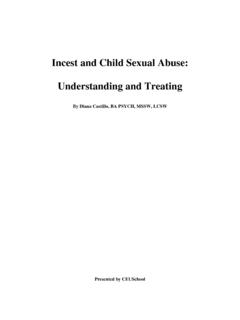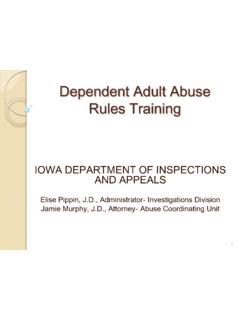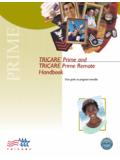Transcription of Be Careful: Personal Safety for Social Workers
1 Be careful : Personal Safety for Social Workers By Jane Harkey, RN, MSW, CCM Presented By CEUS chool Brief Bio: Jane Harkey is a Professional Geriatric Care Manager with a private practice. She has developed and presented many post-graduate continuing education seminars at Rutgers University School of Social Work, Piscataway, New Jersey. She has also delivered numerous presentations at local, state and national conferences as well as developing numerous on-line training modules. Writers Comments Regarding this Topic: Work-related violence against Social Workers is an often unspoken fact of life and, due to various stressors, it appears to be increasing. In 2004, the National Association of Social Workers (NASW) partnered with the Center for Health Workforce Studies, University of Albany, to conduct a national study of 10,000 licensed Social Workers .
2 The response rate was 50%. In response to the question, Are you faced with Personal Safety issues in your primary employment practice , 44% responded yes. The threat of violence impacts on Social Workers both professionally and privately. The need for Personal Safety information is imperative to protect Social Workers and provide preventive strategies to enable them to provide safe, effective client interventions. Brief Course Description: This course will discuss: History of Safety issues for Social Workers Impact of aggression on the well-being of Social Workers Agency Safety rules, regulations and procedures Situational awareness Threat recognition Essential ideas for Personal Safety Protocols while visiting clients in higher risk areas De-escalation techniques Self-protection strategies Course Objectives: After completing the offering, the participant will be able to: 1.
3 Define what is meant by workplace violence 2. List at least 3 reasons why workplace violence appears to be increasing 3. Explain how workplace Safety can impact a Social worker s emotional and physical well-being 4. List at least 3 areas of knowledge that an agency s skill training program should include 5. List at least 4 suggestions for making agency facilities safer 6. Define what information should be included in a pre-visit Safety assessment 7. List at least 2 things Social Workers should know about their clients prior to going into the field 8. List at least 2 essential ideas for Personal Safety for each of the following: in the car and in a client s home 9. List at least 3 indicators to predict client violence 10. List at least 4 signs of increasing agitation 11. List at least 3 de-escalation techniques 12.
4 List at least 2 self-protection techniques if attacked Be careful : Personal Safety for Social Workers INTRODUCTION Work-related violence against Social Workers is an often unspoken fact of life. Probably few Social worker students or new practitioners realize when they enter the profession that they may be targets of assaults. This should really not be a surprise however, because Social Workers usually become involved with clients during periods of crisis and often interact with clients when they are emotionally labile. Violence includes physical assault, verbal assault, harassment and the threat of assault. Some assaults may be minor, but others can be lethal. The violent deaths of some Social Workers have triggered awareness of this issue. The resultant outcome of this awareness is the mandatory training in Personal Safety for Social Workers by some states and schools of Social work, as well as the development of agency policies and procedures to protect Social Workers on-site and during home visits.
5 Even if a state doesn t require these measures, it behooves every Social worker to be aware of the potential threats that may be encountered and how to mitigate these threats of violence. HISTORY OF VIOLENCE AGAINST Social Workers Ever since Jane Adams went into Chicago s tenements to provide Social work, Social service Workers have been at some risk. Because Social Workers go into their field to help others, they tend not to perceive clients as potential threats to their Safety . They have the mindset that their clients want and need their interventions. However, circumstances sometimes change the clients perceptions as to the help Social Workers provide. If they become frustrated or feel a loss of control, their behaviors may become negative. This can result in violence towards the Social Workers . The vast majority of incidents do not involve serious bodily injury.
6 Injuries involving Social Workers have ranged from verbal attacks which require no medical attention to those requiring hospitalizations. Although fatalities are rare, some Social Workers have paid the ultimate price for caring for their clients. Following is a list of some of the Social Workers who have been killed while performing their professional duties: 1987 - Norman Fournier was a Social work mental health coordinator in Washington State. He was shot and killed by a client when he went to pick him up on an involuntary commitment order. 1987 - Paul Grannis was a Social worker in Kentucky. After the removal of an adolescent, a client s father shot him to death while on a home visit. 1988 Linda Rosen was a case manager in a psychiatric hospital emergency room in Pennsylvania. During the intake interview, a client shot her to death.
7 1989 Robbyn Panitch was a Social worker at a mental health clinic in California. A client stabbed her to death during a counseling session. 1991 Tanja Brown-O Neil was a Social worker at a Social services agency in Maryland. She was stabbed by a client who was angry at not receiving his food stamps. 1993 Rebecca Binkowski was a graduate Social work student who was a resident manager at an apartment for mentally ill persons in Michigan. She was stabbed to death while driving one of the tenants. 1996 Linda Silva was a Social worker for the Division of Social Services in Massachusetts. She was shot to death during a home visit by a parent involved in a child custody case. 1996 - Josie Curry, Michael Gregory, and Jimmy Riddle were three caseworkers at the Department of Social Services in South Carolina.
8 They were shot to death at their agency by a client upset that his children were being put into foster care. 1997 Steve Tielker was a Family and Children s Services supervisor in Indiana who counseled sex offenders. He was shot to death by a client on probation for child molestation during a court mandated counseling session. 1998 Donna Millette-Fridge was a Social worker at a community mental health outreach program in Connecticut. She was stabbed to death by a client while walking into work. 1998 Lisa Putman was a Child Protective Services Social worker in Michigan. She was murdered while on a home visit by clients who were upset that their children had been put into foster care. 1999 Nancy Fitzgivens was a Social worker for Child Protective Services in Ohio. She was killed while making a home visit.
9 2004 Teri Zenner was a Social work case manager in a mental health center in Kansas. She was murdered with a chainsaw while on a home visit to see if her client was taking his medication properly. 2004 - Greg Gaul was a licensed private clinical Social worker in Iowa. He was shot to death by a client while on a home visit. 2006 - Boni Frederick was a Social services aide in Kentucky. She was stabbed to death during a home visit by a client who had lost custody of her child. Social WORK VIOLENCE STATISTICS Social Workers may wonder just how dangerous their profession truly is. In 2004, the National Association of Social Workers (NASW) partnered with the Center for Health Workforce Studies, University at Albany, to conduct a national study of 10,000 licensed Social Workers . The study obtained nearly a 50% response rate.
10 In response to the question: Are you faced with Personal Safety issues in your primary employment practice , 44% of the respondents said yes. Also, 30% of those Social Workers did not think that their employers adequately addressed their Safety concerns. The survey determined that the majority of Social Workers facing Safety issues were more likely to: Be in the first five years of their Social work practice (26%) Work in private, non-profit (37%) and state government settings (23%) Work in Social service agencies (17%) Describe their primary area of practice as mental health (35%) or child welfare/family (16%) Another survey by NASW s Committee for the Study and Prevention of Violence Against Social Workers , with the support of the Massachusetts Chapter of NASW, revealed that of the Social Workers they surveyed reported feeling unsafe in their jobs.






